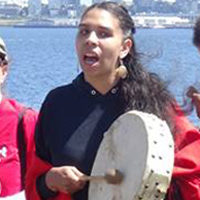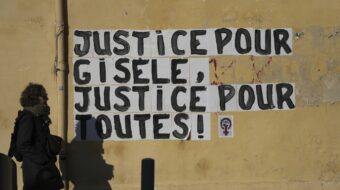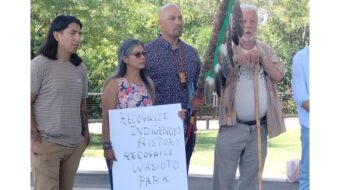
Content Warning: mentions rape, kidnapping, murder, genocide, slavery, violence against women, violence against trans- and gender-nonconforming women.
“I had a vision the ancestors told us to heal the world.
When we heal ourselves, we also heal our ancestors, our grandmothers, our grandfathers, and our children.
When we heal ourselves, we also heal mother earth.”
Grandmother Rita Pitka Blumenstein
I was raised by two amazing Indigenous women: my mother and my grandmother. Their knowledge has been valuable in my life. The knowledge of my mother came from my grandmother and my grandmother got her knowledge from her mother. This includes the knowledge of plant medicines and traditions of my ancestors.
As an Indigenous femme I understand that the knowledge and power that our grandmothers and women hold in our community goes beyond western understanding of leadership, respect and power. It’s tied into the stories we grow up with, the ceremonies we hold, and an understanding of our relationships to our community, the land and water. We hold respect for Mother Earth because she gives us life. We hold respect for water because it is life. Water is the first medicine: babies grow in water. Without water there is no life. Without the roles of women and femmes being respected, there can’t be equality. It’s hard to put some of these concepts into a frame that non- Indigenous peoples can understand. Not because it’s too hard, but because some things can only be understood because they are part of our cell memory. It’s part of who I am.
Growing up, I looked up to my Mom. She was a single, Mixed Native woman who raised three kids. Often she tackled too much at one time. Often I would hear relatives tell her, “Lynn, you are working too hard, you take on too much.” She worked a full time job, went to school, and homeschooled all three of us. Yet she still found time for her community. She still found time to take us to Powwow and Ceremony. My mom in the 60s and 70s fought against racism and the Vietnam War. In the 80s she tried to become an EMT in the Navy. She marched against Seaworld, which was stealing our orcas out of the Salish Sea. She marched against mega fishing companies like Gorton’s Seafood, a company that was overfishing our waters and breaking treaties that coastal tribes have with the United States and Canada. By the age of ten I had been to more marches, rallies and demonstrations than most children my age. My mother tried her best to be a warrior in the modern world. She learned everything she knows from my grandmother.
While my mother was my hero, my grandmother to me was a goddess. My 4’4” Chinook and Haida grandmother held so much power. When she spoke, people listened; when she was angry, people knew better than to sass back. She held generations of knowledge within that small body. She could tell you the history of the whole West Coast. She could tell you the medicines that grow on the hills and mountains. She showed me how to sew, weave, bead, dance, and smoke a fish. When I was younger I often didn’t appreciate all that she taught me.
My grandmother was also ahead of her time. She had non-Native husbands/partners. Three of them were Black. She stood up against anti-Black racism from both the local white logging community and her own Native family. My grandmother would often tell me stories about her parents and her grandparents: how they fought against the first settlers that came into the Pacific Northwest. She saw so much in her 103 years. In 2012 when Idle No More was growing and she called me one afternoon and said “I was just at round dance in the mall! So many Indians in one place! It’s like a dream come true! I believe you are the generation that will end our pain… we have prayed for a long time.” I know I am my ancestors’ triumph. I am their walking prayers.
In 2014 I became a parent to my Koraline Nibii, who is now two and has gone to more meetings and actions then most two year olds and even some adults. She will even tell people: “I march for water.” I’m doing my best to raise her the way I was raised by my grandmother and mother — to teach her both the politics and her culture.
I often ask myself what would my mother do? Or what would my grandmother say? Sometimes I get looks from others at rallies and meetings, seeming to say: “Why does this person have this baby at a Trans Liberation March?” Or: “Why is this person breastfeeding this child during this meeting about fighting for a living wage?” While I can’t take Kora to all marches and meetings, I try to attend as many as I can. First, I do this so I can still be involved in my community and the issues that mean so much to me. The fight against capitalism isn’t going to pause itself because I had a baby. Second, I want Kora to be exposed to as many narratives as possible. I want her to fight for the water, but also understand why we stand for Black lives. And yes I take her out in the cold (bundled up of course) to show her that sometimes we have to be uncomfortable to make a difference. Those are things I learned from my grandmother and mother.
Before colonization, genocide, imperialism, and forced assimilation, many of our Nations were matriarchal and the grandmothers and aunties held a lot of power in the governance of our communities. Native women hold a place of respect because we give life, we carry water in our bodies where our babies grow. Women are also the knowledge keepers. Some women in our Nations were also warriors. They had the power to give life and take it away. Alongside women were our Two-Spirit individuals that hold both female and male within them. Two-Spirit individuals held important roles within our communities. Chiefs could not go to war unless it was approved by the grandmothers and aunties.
Grandmothers were also in charge of restorative justice. They were the law. If someone broke those rules the grandmothers alongside other leaders would figure out punishments. Not punishments in the western sense, but justice that was healing for the community and was fair for those involved. For many Nations, as knowledge-keepers, Native women held the stories and songs. They gave the men the drum to sing and pray with. Two-Spirit femmes would help name the children or raise a child if the parents died. They also fought alongside men in war. Indigenous women are the foundation of our communities.
Who did the European settlers attack and kill first when they reached the Americas? It was the Women and Two-Spirits. Because without the women there guiding the men or protecting the culture, genocide can be accomplished.
After 500-plus years of genocidal tactics our women are the ones rising up and reclaiming their space as leaders in our communities. We are the legacy of the grandmothers who gave everything so we could be here today. We are their pain, prayers, tears and sacrifice that gave birth to a new movement… Idle No More. When the Indigenous liberation movement toned down after Wounded Knee in the 1970s, the world lost track of the fight for Indigenous rights. In 2012 four women — three First Nation women and one non-Native ally — started the movement that has reignited our fight against genocide. That fight was over water.
The fight to protect the water is connected to us as Indigenous women and femmes; we have been charged with the responsibility to protect humanity’s first medicine. Out of Idle No More grew a new Indigenous resistance that would grow to become and movement that focus on protecting the land, water and Indigenous communities from further harm. New warriors were rising up to fight big oil, corporate governments and to begin the decolonization of our people.
In 2016 a group of Native youth took it upon themselves to start a fight against the Dakota access Pipeline. They understood that the pipeline affected more than just the land and water–it affected their communities. These pipelines and mining projects that are happening around Indigenous communities are destroying more than just the land and water. There is also an epidemic of missing and murdered Indigenous women whose numbers continue to rise. Throughout the Americas, wherever Indigenous peoples are fighting for our land and water, we are also fighting to protect our communities from drugs and violence against Indigenous women and femmes.
In April 2016 LaDonna Brave Bull Allard, inspired by Native youth, began working on building the largest movement of Indigenous Nations in over two hundred years. This would grow into the Sacred Stone Camp and many other camps who would stand together in the fight against DAPL. The fight against DAPL has shown the world the leadership, strength and power of Native women and femmes. Native women were on the frontlines getting attacked, sprayed, locked up. Screaming “Mni Wiconi! Water Is Life!” Native women raised those words as a war cry and prayer for our people and the water.
Native women were being medics and healers. Native women led ceremony and prayers for the water. Native women taught language and culture to Native youth who found healing and peace at the camps. Native women cooked three meals a day for thousands of water protectors.
We Native women and femmes took our place as leaders and warriors to protect our people. Even when our family and friends were once again being forcibly removed from Indigenous lands, It was Native women holding people together. It was Native grandmothers once again standing against the powers that would see them destroyed.
On February 23, 2017 armed militarized state police from all over the country came to dismantle and destroy the remaining camps at Standing Rock. But the Grandmothers stood firm in prayer as long as they could. On February 24th, state forces arrested Regina Brave, or “Grandma Regina,” who is a veteran warrior woman who also stood up to militarized forces in 1973 during the occupation of Wounded Knee. Once again it was a grandmother who took a stand to protect her people. The camps at Standing Rock might be shut down but the power of the prayers and actions led by Indigenous women and femmes has awakened Indigenous people like we have never been moved before. This fight isn’t just up here in the North either: Indigenous women and femmes are fighting all over the world. In Hawaii we lead the fight to protect Mauna Kea; In Honduras we are warriors like Berta Caceres, who gave everything to protect the land, water and their people.
Women and femmes have always been warriors
Feminism involves so much more than gender equality and it involves so much more than gender. Feminism must involve consciousness of capitalism (I mean the feminism that I relate to, and there are multiple feminisms, right). So it has to involve a consciousness of capitalism and racism and colonialism and post-colonialities, and ability and more genders than we can even imagine and more sexualities than we ever thought we could name. –Angela Davis
Indigenous women are leading the resistance against colonialism, imperialism and genocide–but so are women and femmes in other oppressed communities. Over the past few years, we’ve seen a rising consciousness of the interconnectedness of struggles against racism, misogyny, imperialism, militarism, homophobia, and transphobia. This consciousness reflects an understanding that these systems of oppression are part of the machinery of capitalism, and that we cannot fight any of them without fighting all of them, and without opposing capitalism itself.
No longer are we having to fight for just one issue at a time, we are having to fight for our issues while fighting to protect the issues that we thought were settled and fixed. In some of our communities, the level of fear and violence that is being experienced has reached new heights with families being torn apart by immigration laws and travel bans, and with the land and sacred sites being destroyed. There has been an epidemic of violence against the Trans community with now eight Trans women who have been killed this year. Laws that promote safe workplaces and protect collective bargaining rights are under attack. The movement to defund and destroy public schools is accelerating. And out of all of this pain and hurt who has risen once again to take the lead and build a movement that can stop Trump and people like him? Women and femmes.
Examples are everywhere. When the Black Lives Matter movement was coalescing in Ferguson, MO, in response to the murder of Mike Brown, one of the first groups to show up in solidarity was the Fight for $15 movement. Not coincidentally, women and femmes of color are leaders in both movements. The fight against police brutality and state violence also expanded to address the growing number of murdered or missing trans women.
In the fight to end deportations of Latinx families, Latinx women and femmes are standing strong against racist and anti-Indigenous policies who impose and enforce settler colonial borders. Muslim Women are leading the fight against Islamophobia and xenophobia and standing in fierce solidarity with Latinx women and femmes for immigration justice. BIPOC (Black, Indigenous, and people of color) women and femmes are standing up for reproductive justice that is radical and intersectional. This includes reproductive justice organizations like Native Youth Sexual Health Network and Sister Song. Sister Song was started by Black women to tackle reproductive justice in BIPOC communities that were being overlooked.
But it would be a mistake to think that the leadership of women and femmes in the fight for justice is something new. Women and femmes have always been warriors.
For a recent example, we in the LGBTQ2S+ movement owe the foundation of the queer rights movement to Black trans women. The modern pride movement was launched by Black and Latinx trans and gender non-conforming femmes who fought back against police at the Stonewall Inn. Marsha P. Johnson, Miss Major Griffin-Gracy, and Sylvia Rivera took a stand on June 28th 1969 on Marsha’s 25th birthday. Fed up with violence that they faced, they started a riot outside of the Stonewall Inn. From that small action grew the Movement for LBGTQ2S+ liberation and the fight for queer visibility. There wouldn’t be a Pride month without them, yet people are unaware of these heroes and what they did.
But this goes all the way back, before the European ruling class enlisted Christianity as a way to demonize women and femmes by enforcing binary gender and a gendered division of labor. Back before capitalism required policing the reproduction of a labor force, and before women were treated as property that could produce other property. Women in many cultures were knowledge keepers, healers and warriors. Midwives who understood plant medicines and guided other women in childbirth. Women who were warriors, spear holders, archers and shield maidens. Women in the ancient world were Queens, Clan leaders, Earls, and Empresses. And those traditions of leadership by women and femmes nourished the resistance to capitalism, colonialism, and slavery. Jamaican national hero Queen Nanny of the Maroons led escaped slaves in a war against British occupation. In the United States, Harriet Tubman led enslaved people to freedom and Sojourner Truth fought for both abolition and women’s rights.
But with this role of women and femmes as knowledge keepers and resistance leaders, came vicious repression, an attempt to police women’s bodies and women’s knowledge. Sometimes the violence was direct, as with witch trials and laws restricting reproductive choice. But it also took the form of an historical erasure. Science, political leadership, military prowess, and, yes, even resistance became identified with men. The contributions of women and femmes were buried. Any who tried to reclaim these attributes were labeled as shrill, uppity, nasty, unfeminine… and dangerous.
Now it is 2017 and we have #45 in the White House and like minded people in leadership who want to dismantle the gains that our grandmothers worked and died for. On January 21st 2017, women and femmes took to the streets and demanded to be heard.
The Women’s March did two things. It sent a message that women will rise when others would not. And that the topic of Intersectional Feminism must be at the front and why our feminism must stand up for all women. It insists that we continue to dismantle and decolonize the systems that were placed to silence women and femmes.
Today, we march once again for International Women’s Day. And this year women and femmes are being asked to go on strike from all forms of labor, paid and unpaid. We are asked to stop what we are doing and march in the footsteps of our grandmothers. Women will continue to rise. Mni Wiconi!! Black Lives Matter! Black Trans Lives Matter! Trans Up Front! No ban! No wall! No war on women! Let’s our voices echo to the next seven generations. Let’s create a world where all women and femmes are once again valued and respected.












Comments